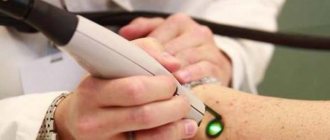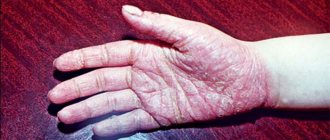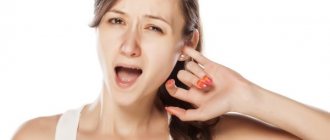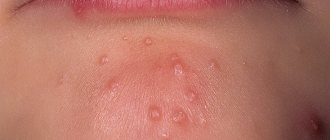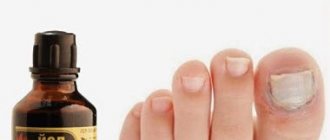Miliaria is a specific form of dermatitis that occurs as a result of skin irritation due to excessive sweating.
Miliaria occurs as a result of increased temperature (both the environment and the body itself), as well as due to violations of hygiene rules, which disrupts the functioning of the skin glands - sweat and sebaceous, which causes a skin response.
Most often, newborns and young children suffer from heat rash, since their skin is very thin, delicate and sensitive, but adults who have metabolic problems, are overweight and violate hygiene standards, preferring tight and non-breathable clothing, can also suffer.
Causes
Miliaria mainly affects areas of the skin with insufficient ventilation:
- areas of natural folds of the body (armpits, groin area, knee and elbow bends),
- the area under the mammary glands in women and very obese men,
- the area behind the ears in children and adults with thick hair,
- the area between the thighs, if the legs are very full,
- the area that is constantly under clothing (the area under a bra, swimming trunks, diapers), bandages, bandages.
Contribute to the development of prickly heat:
- synthetic clothing, dense non-breathable fabrics,
- feverish conditions,
- elevated air temperatures combined with high humidity,
- skin injuries and chafing,
- the use of creams, oils, fatty cosmetic bases that clog pores,
- diabetes, metabolic diseases, excess weight.
How to prevent heat rash in newborns
- Your baby will not develop heat rash even in the hot summer if you always dress your child according to the weather and monitor the temperature in the children's room;
- choose clothes for your baby not based on “beautiful”, but on the quality of “breathable” materials;
- dress your child in loose clothing;
- change your baby’s diapers regularly and often leave him naked to “ventilate”;
- bathe your baby daily;
- do not swaddle your baby too tightly;
- use powders and baby creams exclusively on a water basis;
wash children's clothes with special hypoallergenic products.
Development mechanism
An increase in body temperature leads to the activation of protective mechanisms for cooling it - the pores open and sweat appears, which cools the body.
If the sweat glands are clogged with sebum, cosmetics, or if the air is humid and hot, then the sweating process suffers. Sweat evaporates slowly, causing skin irritation.
Sweat contains salts and biologically active substances that can have an irritating effect on the skin. If excess sweat is not removed in a timely manner, the microbes that are always there begin to actively multiply on the skin - the process of inflammation of the sweat glands occurs - prickly heat, a small rash, is formed, accompanied by various subjective unpleasant symptoms.
Why does it often occur in newborns?
If your baby has heat rash, don’t worry, because you can get rid of it quite quickly if you follow simple rules for caring for your child’s skin. Just try to start treatment as early as possible so that the process does not reach a serious stage.
Usually prickly heat in babies occurs in the summer heat. But, if you are used to wrapping your child in a blanket that is too warm in winter and spring, then it may appear in the cold season. When a baby's sensitive skin is severely irritated, a small red rash appears on it - the main sign of heat rash.
Why is the skin of newborns prone to prickly heat? It's all about unformed sweat glands, which will begin to work in normal thermoregulation mode only by the age of 5-6 years. In addition, children's skin is still very thin and sensitive, it has very powerful blood circulation, and it consists of 85% water (unlike adult skin, which retains only 65% moisture).
The processes of constriction and dilation of blood vessels, which occur quickly in an adult body, are still slowed down in a child’s body - so thermoregulation also occurs very slowly. This is why the newborn’s body overheats and becomes hypothermic instantly.
Symptoms of prickly heat
Papular miliaria
This form occurs more often in adults in hot summer conditions and high humidity.
With the papular form of miliaria, rashes appear on the skin in the form of small, flesh-colored blisters, which average 1-2 mm.
Typically, blisters appear on the sides of the chest and abdomen, on the arms or legs.
In addition to the manifestations of prickly heat, peeling and severe dryness of the skin are characteristic, causing itching and discomfort.
Miliaria rubra
With the red form of prickly heat, nodules and blisters up to 2 mm in diameter appear, filled with cloudy contents, surrounded by a halo of redness.
The blisters do not merge into a single field and are very itchy, especially with increased sweating and an increase in the temperature of the skin and air.
This type of prickly heat manifests itself especially strongly in places of friction - between the buttocks, under the diaper, under the breasts of women, between the thighs. This type of heat rash also occurs more often in adults.
Crystal prickly heat
The crystalline form of miliaria usually occurs in children.
These are white or translucent blisters no more than 1 mm in size, the blisters tend to merge and form larger zones, they can burst and dry out, forming crusts and peeling, easily become infected, and give rise to the development of pyoderma (pustules on the skin). They occur in the forehead and face area, on the neck and torso, and can be on the shoulders and back.
Miliaria can cause severe itching and swelling of the skin, especially in children, mimicking many other diseases.
The prickly heat rash can easily be confused with skin manifestations of infectious or allergic diseases (measles, chickenpox, urticaria)
Due to the tenderness of the skin and weak immunity, prickly heat in children is often complicated by the addition of a secondary infection, progresses quickly and leads to weeping and diaper rash.
Classification
In medicine, there are various types of diseases, each of which has its own development characteristics, symptoms and treatment. Main types of rashes:
- Red;
- Crystalline;
- Papular;
- Apocrine.
Depending on whether the disease is limited to external signs in the form of a rash, or whether additional symptoms appear (itching, intoxication), prickly heat is uncomplicated or complicated.
Red uniform
The red form of the rash refers to the inflammatory forms of the dermatological disease. It is the appearance of red, small bubbles with a cloudy liquid inside. They itch and cause severe discomfort; a person rips them off, and in their place weeping crusts appear. Miliaria rubra on the skin most often appears in obese women. Requires complex and lengthy treatment.
Crystal form
The crystalline type of rash is one of the most common and safe forms of the disease. The rash has the appearance of small multiple blisters of a light scarlet hue, which can merge with each other and form large areas of rash. The course of prickly heat is not accompanied by itching, burning or other uncomfortable sensations.
Papular form
Miliaria papularis is also known in medical practice as deep heat. It is considered one of the most severe types of skin disease and is most often an advanced stage of the red form of the rash.
With this disease, papules no larger than 2 mm in size form on damaged areas of the skin, accompanied by itching and burning of the skin. In addition, papular miliaria in adults, the symptoms of which are described above, is accompanied by manifestations of general intoxication of the body - weakness, lethargy, pain, increased body temperature, swelling and redness of the affected areas of the skin.
Apocrine miliaria
Most often it occurs due to insufficient hygiene. In adults, it is characterized by a bright pink or red rash without blisters.
Most often it develops under the armpits, in the groin area, on the nipple areo, in the groin area in men and on the labia in women. This is explained by the highest concentration of apocrine glands in the above areas, where irritation occurs.
Treatment of heat rash
The basis for the treatment of prickly heat in both children and adults is access of air to the skin and hygiene.
You should not wrap your child up, dress him too warmly, or wear things that increase sweating.
Avoid wearing synthetic or tight clothing in hot, humid climates and excessive use of soap.
- If there are rashes, drying measures are necessary - bathing in herbs (chamomile, oak bark), treating the skin with cotton swabs with herbs.
- When sweating in the area of natural folds, powders help - baneocin, talc, potato starch.
- When miliaria infection occurs, the skin is treated with a slightly pink solution of manganese. Dermaveit products, an emulsion with zinc oxide, help - they relieve itching and redness.
- Treating the affected areas of the skin with an antiseptic solution (for example, an alcohol solution of salicylic acid).
- To reduce itching in adults, apply topical ointments with betamethasone 2 times a day for 3 days, as well as preparations containing menthol and camphor.
- For bacterial infection, take antimicrobial drugs.
For heat rash, creams, oils and greasy lotions are prohibited; they will only worsen the situation.
If severe sweating occurs in adults, it is necessary to consult a doctor and treat the manifestations of hyperhidrosis (excessive sweating).
Physical activity in hot rooms and wearing warm clothes should be avoided.
Slow acclimatization to hot climates is recommended.
Allergies, chickenpox and prickly heat: how to distinguish?
As already mentioned, the main symptom of prickly heat is a rash and redness of the skin. These manifestations of miliaria may affect only one area of the baby's body (for example, the armpits or groin), or they can spread more widely. If your child is very young, the symptoms of heat rash can be irritating, causing anxiety and disrupting sleep. But since chickenpox, measles and allergies begin with symptoms similar to prickly heat, it is better to show the baby to a pediatrician.
How to understand that a child has heat rash and not another disease? Remember: have you violated the hygiene rules for caring for your baby’s skin over the past few hours? Namely:
- if you have poorly maintained hygienic skin care, miliaria in newborns appears in the neck area;
- if the child overheats and has been wearing clothes made of synthetic fabrics for some time, prickly heat will appear on the back;
- if you often apply a rich cream in the groin area and rarely remove your baby’s diaper, prickly heat will develop in the groin area and buttocks;
- if the rash from prickly heat that appears on the neck is not treated in time, it can spread to the face;
- when the baby is constantly wearing a hat (even at home and on hot days), a rash may appear in the head area.
If you treat the baby’s delicate skin in a timely manner and follow the rules of care, the prickly heat will go away quite quickly. But a rash due to infection or an allergic reaction, on the contrary, will spread progressively.
Folk remedies for prickly heat
People who have suffered from prickly heat for a long time know how to get rid of unpleasant symptoms with some simple techniques:
- Enriching the diet with plums, lentils, pomegranate juice and sorrel. These herbal products regulate sweating and reduce the irritating effect of sweat on the skin.
- Using laundry soap when washing skin. Laundry soap does not contain perfumes, dries bubbles well and cleanses the skin of drying elements.
- Using soda solution. Twice a day it is recommended to lubricate the bubbles with a soda solution (1 tsp per glass of boiled water), which has an antiseptic and drying effect.
- Disposable wipes are a handy cure for prickly heat. Using gentle paper napkins, gently blot the weeping elements with the released serous contents - to do this, carefully apply the napkin to the rash, lightly press it and also carefully remove it. You can use wet wipes with menthol.
In each case of prickly heat, treatment should begin with hygiene - sometimes this is enough to forget about unsightly rashes after a couple of days.
Author:
Sabuk Tatyana Leonidovna hygienist, epidemiologist
When and which doctor to contact
The patient copes with the first stage of prickly heat on his own. If severe swelling, crusts and pustules appear, the help of a dermatologist is required. After communicating with the patient, studying his medical record, and external examination, the doctor determines the cause of the condition and suggests measures to eliminate it. You may need to donate blood for a general analysis or to determine hormone levels.
The underlying disease is treated simultaneously with the elimination of signs of prickly heat. Medicines are prescribed by a doctor. Folk remedies are also used after its approval. If you are obese, you may need the help of a nutritionist. If the disease is associated with ovarian dysfunction during menopause, consultation with a gynecologist is advisable. Self-medication often causes serious complications, defects on the skin of the face and other parts of the body.
How to treat diaper rash under the breast?
It is necessary to combat diaper rash under the mammary glands in a comprehensive manner using hygiene procedures, medications and traditional methods. Any therapeutic regimen must be agreed with the doctor so as not to overdo it with the number of procedures.
Pashkova Alla Valerievna
Obstetrician-gynecologist, candidate of medical sciences.
Ask a Question
At the beginning of the treatment of advanced cases of diaper rash, blood tests, urine tests, blood sugar tests, and bacterial examination of a smear from the problem area are prescribed. Only after this the doctor decides on a treatment regimen.
Hygiene procedures
You can avoid the progression of diaper rash using the following hygiene measures:
- Regular (2-3 times a day) shower or bath with herbal infusions of oak, string or chamomile. Skin irritation after showering can be relieved by using a hairdryer on a cold setting.
- Place well-ironed cotton cloth or gauze between the chest and body to reduce friction. It should be changed every day.
- During treatment, it is necessary to choose a bra without hard or synthetic parts. Its material must allow air to pass freely and be hygroscopic.
- Avoid physical activity accompanied by profuse sweating.
You should not over-wash the problem area, because this dries out the skin and prevents its regeneration.
What ointment to use for diaper rash under the mammary glands?
When treating diaper rash under the mammary glands, a number of ointments are used, each of which is used in special cases. Before applying the drugs, it is recommended to treat the skin with antiseptics: a solution of potassium permanganate, chlorophyllipt or furacillin.
Warning! This photo contains information not intended for viewing by persons under the age of 18!
If there is swelling in the folds of the breasts and exudate appears, then drying ointments are used: linin, Teymurov ointment, Lassar paste. They contain zinc, antiseptic and anti-inflammatory components, which, along with drying, also have an additional therapeutic effect. They are used mainly at the beginning of therapy.
In the presence of infected ulcers, erosions and cracks, local ointments with antibiotics are prescribed: Levomekol, Clotrimazole, Lorinden S, Sintomycin and others. Their use is more effective when alternating with drying drugs. The use of antibacterial ointments should be limited in time: after signs of infection disappear, their use can be stopped.
After eliminating active exudative manifestations and infection, skin treatment with ointments with a regenerative effect is prescribed: tar paste, panthenol, methyluracil ointment, bepanthen and others. Their use is combined with ongoing hygienic procedures, which are carried out until the signs of the disease completely disappear.
At the final stage of treatment, the skin under the mammary glands can be smeared with baby diaper rash cream or regenerating ointment for 1-2 weeks. This helps the skin restore its protective functions and eliminate the likelihood of relapse of the disease in the short term.
Treatment of diaper rash with folk remedies is justified only if classical methods of drug therapy are unavailable.
Prevention measures
In order to prevent the development of a disease such as heat rash on the back of an adult, as well as in other parts of the body, it is enough to follow a few simple rules of prevention.
- The wardrobe should contain only clothes made from natural fabrics that allow air to pass through and allow the skin to fully “breathe”.
- The room temperature should not be too high.
- You need to carefully monitor your weight, as extra pounds provoke the development of skin rashes.
- Clothing should not squeeze or rub the body.
- After bathing, dry your skin.
These simple rules will reliably protect against dermatological diseases in adults, restore the normal functioning of the sweat glands and ensure beauty and health to the skin.
Accurate diagnosis
The disease is diagnosed during an examination in a dermatologist's office. To exclude pyogenic and yeast infections, toxic erythema, additional examination is carried out.
It is difficult to distinguish heat lichen from urticaria. But the first is characterized by a rash in areas of increased sweating. When the skin is stretched, it disappears. Allergies are accompanied by accompanying symptoms:
- Purulent conjunctivitis.
- Drowsiness.
- Weakness.
- Dyspnea.
- Runny nose.
- Cough.
- Headache.
- Tearing.
If a violent reaction develops, the allergen is found and human contact with it is eliminated.



